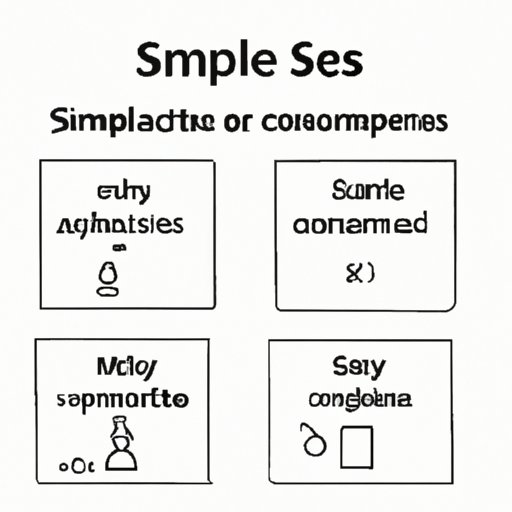
I. Introduction
When we simplify expressions, we are essentially reducing them to their most basic format. This process can be used to solve equations, manipulate formulas, and solve real-world problems. Simplifying expressions is an essential skill for learners of all levels; it builds a strong foundation for algebra, calculus, and other mathematical disciplines. In this guide, we will provide learners with a step-by-step approach to simplify expressions effectively and efficiently.
II. Step-by-Step Guide
The first step to simplifying expressions is to identify the different parts of the expression and their relationship to one another. Depending on the expression, there may be numbers, variables, and operations that need to be accounted for. We will guide you through each step with clear and concise explanations.
Let’s start with a basic expression:
2 x + 4 x
The first step is to combine the like terms by adding their coefficients:
6 x
This is a simplified expression, with a smaller number of terms and coefficients compared to the original expression.
III. Multiple Examples
We will now demonstrate various patterns and approaches to simplifying expressions through multiple examples. Each example will show different types of expressions, both simple and complex, and demonstrate how to simplify them:
Example 1:
3 x + 5 y – 2 x + 4 y
The first step is to combine the like terms:
3 x – 2 x + 5 y + 4 y
Next, we add the coefficients of the like terms:
x + 9 y
Example 2:
2 a (3 b + 4 c) – 3 b (2 a – 3 c)
We begin by using the distributive property:
6 a b + 8 a c – 6 a b + 9 b c
Then, we combine the like terms:
8 a c + 3 b c
IV. Graphic Representation
To further enhance learners’ understanding of simplifying expressions, we will use flowcharts, diagrams, or other visual aids to illustrate the process. These visual aids will provide annotations for each step and show how learners can simplify expressions quickly and effectively:

V. Simplification Rules
There are different rules that can be used to simplify expressions, such as distribution, combining like terms, and factoring. Understanding these rules will allow learners to simplify expressions in different contexts. Here are some examples for each rule:
Distribution:
3 (x + 2 y) = 3 x + 6 y
Combining like terms:
4 x + 3 x = 7 x
Factoring:
x^2 + 4 x + 3 = (x + 1) (x + 3)
VI. Common Mistakes
When simplifying expressions, learners may make common mistakes. These mistakes can be avoided by using strategies such as checking the signs, simplifying within parentheses, and being cautious with negative signs. Here are some typical mistakes and how to avoid them:
Mistake: Forgetting to distribute correctly.
Strategy: Check each term and make sure that it has been distributed correctly.
Mistake: Combining unlike terms.
Strategy: Make sure that the terms being combined have the same variable and exponent.
Mistake: Overlooking negative signs.
Strategy: Be cautious when dealing with negative signs and double-check your work.
VII. Practice Exercises
Now that you have a good understanding of simplifying expressions, practice is essential to solidify your knowledge. We have provided a range of practice exercises for you to test your understanding, with answers or solutions provided for each exercise:
Exercise 1: Simplify 4 (x – 2) + 3 (4 x + 2)
Solution: 16 x – 5
Exercise 2: Simplify 2 x^2 + 4 x – 6 x^2 – 8
Solution: -4 x^2 + 4 x – 8
Exercise 3: Simplify 3 a (2 b + 5 c) + 4 b (a – 3 c)
Solution: 6 ab + 2 ac – 12 bc
VIII. Conclusion
In conclusion, simplifying expressions is an essential skill for learners of all levels. By following our step-by-step guide, exploring multiple examples, utilizing graphic representation, understanding simplification rules, avoiding common mistakes, and practicing exercises, learners will be able to simplify expressions effectively. Remember to keep practicing and applying these techniques in real-world situations.





